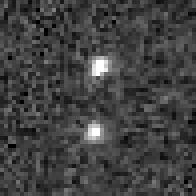Astronomy:88611 Teharonhiawako
 Hubble Space Telescope image of Teharonhiawako and its companion Sawiskera, taken in 2010 | |
| Discovery | |
|---|---|
| Discovered by | Deep Ecliptic Survey |
| Discovery date | 20 August 2001 |
| Designations | |
| (88611) Teharonhiawako | |
| Pronunciation | moh |
| 2001 QT297 | |
| Minor planet category | TNO · cubewano[1] cold[2] |
| Orbital characteristics [3] | |
| Epoch 13 January 2016 (JD 2457400.5) | |
| Uncertainty parameter 3 | |
| Observation arc | 4463 days (12.22 yr) |
| |{{{apsis}}}|helion}} | 45.235 astronomical unit|AU (6.7671 Tm) |
| |{{{apsis}}}|helion}} | 42.454 AU (6.3510 Tm) |
| 43.845 AU (6.5591 Tm) | |
| Eccentricity | 0.031712 |
| Orbital period | 290.32 yr (106041 d) |
| Mean anomaly | 158.44° |
| Mean motion | 0.0033949°/day |
| Inclination | 2.5834° |
| Longitude of ascending node | 304.78° |
| 236.43° | |
| Known satellites | Sawiskera moh |
| Physical characteristics | |
| Mean diameter | 220+41 −44 km (combined) 178+33 −36 km (primary) 129+24 −26 km (secondary)[4] |
| Mass | 2.445×1018 kg[5] |
| Mean density | 1.15+0.87 −0.91 g/cm3[4] |
| Sidereal rotation period | 4.7526±0.0007 h[6] |
| Geometric albedo | 0.145+0.086 −0.045[4] |
| Absolute magnitude (H) | 6.00±0.13[6] 5.8[3] |
88611 Teharonhiawako (provisional designation 2001 QT197) is a trans-Neptunian object and a member of the cold classical Kuiper belt, measuring about 220 km in diameter. It is a binary object, with a large companion named Sawiskera (formally designated (88611) Teharonhiawako I Sawiskera), which at 126 km in diameter is about two-thirds the size of its primary.[7] The two components together are known as the Teharonhiawako–Sawiskera binary system.
Discovery
Teharonhiawako was discovered on August 20, 2001, by the Deep Ecliptic Survey, and Sawiskera was identified a month later.
Naming
The primary is named after Teharonhia꞉wako, a god of maize in the Iroquois creation myth, while the secondary is named after his evil twin brother Sawiskera. The objects were named in 2007.[7]
Binary
Teharonhiawako and Sawiskera is a binary minor planet which orbit each other. Their orbit has the following parameters: semi-major-axis—27670 ± 120 km, period—828.76 ± 0.22 days, eccentricity—0.2494 ± 0.0021 and inclination—144.42 ± 0.35°(retrograde). The total system mass is about 2.4 × 1018 kg.[5]
References
- ↑ Marc W. Buie (2005-07-11). "Orbit Fit and Astrometric record for 88611". SwRI (Space Science Department). http://www.boulder.swri.edu/~buie/kbo/astrom/88611.html.
- ↑ Mike Brown's "How many dwarf planets are there in the outer solar system?" "How many dwarf planets are there in the outer solar system? (updates daily)". http://www.gps.caltech.edu/~mbrown/dps.html.
- ↑ 3.0 3.1 "JPL Small-Body Database Browser: 88611 Teharonhiawako (2001 QT297)". Jet Propulsion Laboratory. https://ssd.jpl.nasa.gov/sbdb.cgi?sstr=88611.
- ↑ 4.0 4.1 4.2 Vilenius, E. et al. (2014). ""TNOs are Cool": A survey of the trans-Neptunian region X. Analysis of classical Kuiper belt objects from Herschel and Spitzer observations". Astronomy & Astrophysics 564: A35. doi:10.1051/0004-6361/201322416. Bibcode: 2014A&A...564A..35V.
- ↑ 5.0 5.1 Grundy, W. M.; Noll, K. S.; Nimmo, F.; Roe, H. G.; Buie, M. W.; Porter, S. B.; Benecchi, S. D.; Stephens, D. C. et al. (2011). "Five new and three improved mutual orbits of transneptunian binaries" (pdf). Icarus 213 (2): 678. doi:10.1016/j.icarus.2011.03.012. Bibcode: 2011Icar..213..678G. http://es.ucsc.edu/~fnimmo/website/Grundy_KBO.pdf.
- ↑ 6.0 6.1 Vilenius, E. et al. (2014). ""TNOs are Cool": A survey of the trans-Neptunian region VI. Herschel>/PACS observations and thermal modeling of 19 classical Kuiper belt objects". Astronomy & Astrophysics 541: A94. doi:10.1051/0004-6361/201118743. Bibcode: 2012A&A...541A..94V.
- ↑ 7.0 7.1 Wm. Robert Johnston (6 May 2007). "(88611) Teharonhiawako and Sawiskera". Johnston's Archive. http://www.johnstonsarchive.net/astro/astmoons/am-88611.html.
External links
- 88611 Teharonhiawako at AstDyS-2, Asteroids—Dynamic Site
- 88611 Teharonhiawako at the JPL Small-Body Database
 |

